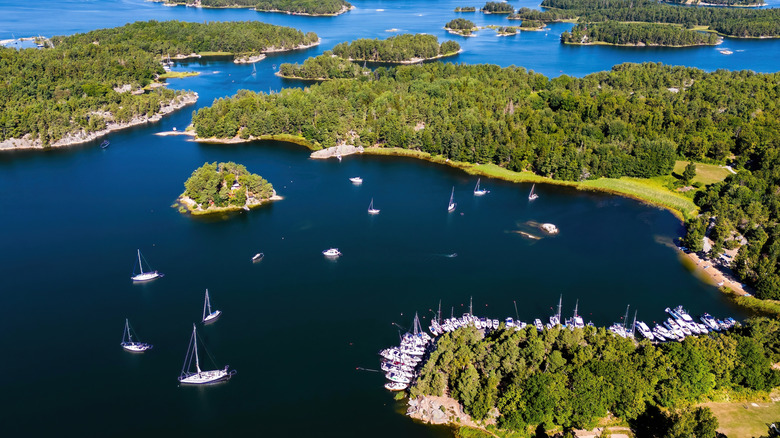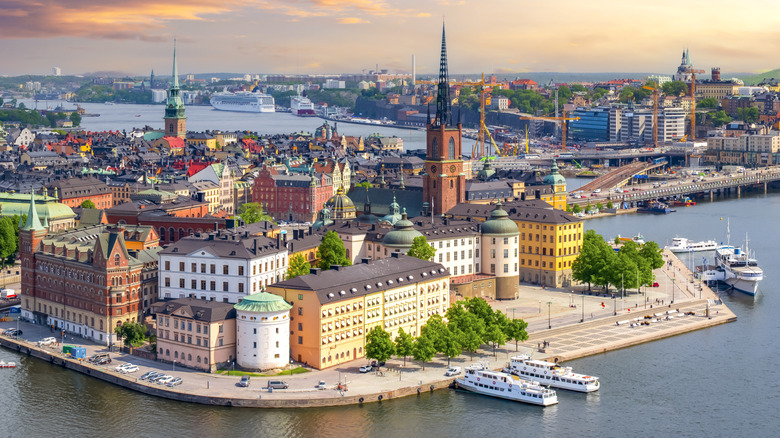
According to a survey, Sweden, with its 267,570 islands, has more islands than any other country in the world. The figures, which rank the United States fifth, are based on data compiled by WorldAtlas, which sources national figures from mapping agencies, statistical offices, and geospatial surveys. But it's worth noting that most countries apply their own definition of what qualifies as an island. Some, like Sweden, count any landmass of 270 square feet or larger that is surrounded by water at high
tide, while others use much stricter definitions.
Regardless, Sweden's islands are phenomenally pretty, with vivid archipelagos that blend of cities and woodlands, castles and nature reserves. Some of Sweden's islands are rugged Arctic outposts like the Bothnian Bay archipelago, where you can see the Northern Lights. Others are sun-dappled islets in the Baltic Sea, perfect for laid-back sunny vacations. And only a fraction — less than 1,000 — of the islands are inhabited, according to data from World Population Review.
The main international airport in Sweden is the Stockholm Arlanda Airport. You can reach central Stockholm from the airport by direct train in around 20 minutes. If you're on a longer journey in Europe, you could also reach Sweden by ferry. A popular sailing option to Stockholm is from Estonia's Tallinn, one of Europe's most underrated capitals, a route that crosses the Baltic Sea in around 16 hours.
Read more: European Destinations That Are Best To Visit In December
An Introduction To Stockholm

A nice introduction to Sweden and its islands can be found in the capital, or rather, above it. Flying over Stockholm, whether arriving or on one of the city's popular helicopter tours, reveals just how many islands make up the capital. Set on an archipelago of about 30,000 islands and islets, these little protrusions of land are scattered like stepping stones between Lake Mälaren and the Baltic Sea, with towns like Vaxholm, Grinda, and Sandhamn also a part of the archipelago.
Put foot to cobble in the city and you'll find that Stockholm unfolds across 14 main islands, connected by 57 bridges and an ornate network of metro stations, many of which have beautiful mosaics, colorful frescoes, and modern art. Many of Stockholm's most popular attractions are on Djurgården Island, home to the Vasa Museum, the Viking Museum, and a large, scenic stretch of the National City Park. Stockholm's old town, Gamla Stan, is spread across several islands and islets, the main one being Stadsholmen. Look out for the imposing Kungliga Slottet (Royal Palace) towering above a quay usually filled with tour boats. Södermalm has a slightly bohemian edge, with old-school single-screen cinemas, cute cafes, and specialist museums, covering everything from silk weaving to photography.
Another way to experience Stockholm's islands is by taking a trip on the water, either by ferry or a sightseeing tour on a charming amphibious bus that runs on both land and water. If you want a more hands-on adventure, you can also sail or take a kayak tour, taking in everything from the city center sights to the leafier parts of the archipelago outside of Stockholm.
Exploring More Of Sweden's 267,570 Islands

Another of Sweden's archipelagos is the Gothenburg Archipelago, the southernmost of Sweden's island groups. While much smaller in scale than the Stockholm Archipelago, it has plenty to offer, including Hvrångö, a quiet, car-friendly island full of beaches, and Asperö, a popular summertime swimming spot. A good option for a more laid-back exploration of Sweden's island life can be found on the rustic beaches and pine-scented forests of the Holmöarna archipelago and the beautiful Holmön, one of Sweden's sunniest islands and a picturesque outdoor retreat away from the crowds.
Among Sweden's islands, Gotland is the largest — and the biggest island in the Baltic Sea. But what makes it especially worth visiting is its distinct identity shaped by centuries of culture, trading, and Viking history. Its main town, Visby, is a UNESCO World Heritage Site encircled by a 2-mile (3.4-kilometer) medieval wall and crisscrossed by cobbled lanes. There are hundreds of medieval houses in the city, many with links to the Hanseatic League, which established Visby as a center of trade in the Baltics. The city is also known for its rose-filled, earning it the nickname "City of Roses."
Beyond the historic core, Gotland offers wild, sandy beaches, fossil-studded cliffs, peculiar limestone monoliths left by the last ice age, and calming pine forests. Hiking is fantastic on Gotland, with plenty of trails leading through countryside and open onto unspoiled beaches, perfect for a refreshing swim. The island's main hiking route is the Östkustenleden, stretches along the east coast through lush forests, beaches, and stunning natural lakes like Lake Tvingen.
Ready to discover more hidden gems and expert travel tips? Subscribe to our free newsletter for access to the world's best-kept travel secrets.
Read the original article on Islands.












